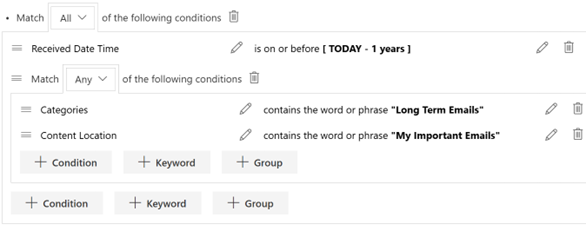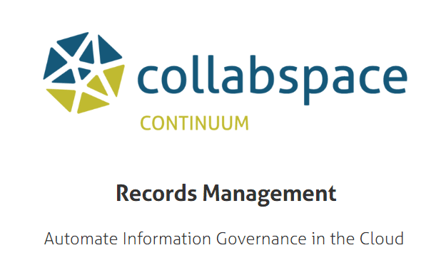 Records Classification is a hot topic. Discussions surrounding records classification do not seem to cease, as this continues to be the centre of records management issues experienced by many. In my view as a records manager, the importance of classification often tends to be misunderstood or dismissed by end-users and even IT professionals. On the other hand, I realize that records managers should put more effort into developing strategies that address the concerns expressed by others.
Records Classification is a hot topic. Discussions surrounding records classification do not seem to cease, as this continues to be the centre of records management issues experienced by many. In my view as a records manager, the importance of classification often tends to be misunderstood or dismissed by end-users and even IT professionals. On the other hand, I realize that records managers should put more effort into developing strategies that address the concerns expressed by others.
For those new to the concept, classification is the "systematic identification and arrangement of business activities and/or records into categories according to logically structured conventions, methods, and procedural rules represented in a classification system" (ISO 15489-1).
The term is also referred to as classification system, classification scheme, file plan, and records retention and disposition schedule (makes up a part of a classification system). Readers may also point out that classification and classification system are considered two different terms. In this blog, I treat both the same, but either approach is fine; basically, classification is represented in a system (classification system).
The need to classify – why classification is important
1. Classification provides context of records
Many people, particularly IT professionals, question the need for classifying documents when enterprise systems can fully index content. Indexing of content or metadata is not sufficient for establishing the context of records. This is important because we can segregate records of value from records of little or no value. While the value of certain information can be a subjective matter and differs depending on the goals for seeking the particular information, records classification helps narrow down places where reliable information may reside.
Subsequently, it aids searchability. When there is a particular topic of records to search but hardly any information other than a few keywords are provided, users initiate the research by identifying classifications that may apply to that particular topic. When records are filed properly and/or they are audited systematically by records managers, the success rate for this methodology is often high.
2. Classification specifies retention and disposition of records
“Storage is cheap, so why bother deleting data?” is another popular remark I often hear others say. Indeed portable storage units are getting cheaper. But to acquire sturdy, reliable and corporate-capable storage can be expensive. In fact, why keep records when you don’t need them or are not required to keep them and become subject to unnecessary litigation? Records that are destroyed according to law and organizational policy along with the retention/disposition schedule are far less likely, or not at all likely, to be subject to litigation or accused of spoliation. This is a financially sound risk management strategy.
4 Tips To Improve Filing Accuracy
Many would agree with me that an Electronic Document Records Management System (EDRMS) is only as good as its implementation success rate. An organization may have purchased the most up-to-date records management application with all the bells and whistles, but if end-users do not favour using it, the application hardly has any value or use to the organization. In other words, if records are not filied to the correct classification, they cannot be found easily, and the retention and disposition applied to them may be incorrect. On the other hand, end-users often find identifying the correct classification to file documents a time-consuming task while others fear filing them incorrectly. Here are 4 tips to improve your organization's filing accuracy while allowing users to classify records more easily:
1. Simplify your file plan scheme
Do you have too many classification code subsets or subsets of subsets? While end-users often favour a desktop folder-like structure, it can also be a cumbersome task to continuously drill down to aggregates of aggregates to find the right classification. Analyze which aggregates can be grouped together and which should be broken down. Break down groups only if functional activities seem too broad, the volume of records they fall under are so high that it is hard to navigate through them or manage them, or when the retention schedules are significantly different.
2. Use easily recognized codes
File codes should be easy to recognize. Utilize numeric or alphabetic codes that are easy to identify or frequently used by end-users as part of their business activities.
- Acronyms and abbreviations can be easier to recognize, if they are adopted organization-wide. Incorporate them as part of the classification code. Which classification code is easier to understand and identify? For Circulation – Times Magazine, "055-33" or "055-TIMES"?
- Incorporate unique identifiers or device numbers that the organization (office of the primary responsibility) uses to specify any procedural or contract documents. The fewer numbers or codes users need to become familiar with, the easier it is to adopt.
3. Create Cheat-sheets For Users
Perform a quick analysis of the end-user’s (or his/her colleague’s) types of documents they often generate or receive. Find those codes and create a commonly-used-classification list for the user to use as a reference. Or create a list for a group of users who share a similar job responsibility.
4. Consider an Intuitive Solution
What if we can still classify documents correctly while freeing users from having to perform that task? Can we really have the cake and eat it, too? Collabware CLM for SharePoint offers a way to classify documents automatically by utilizing a type of metadata value that end users input or select as part of their regular activities. For example, when a user creates a Contract document and inputs a contract number into the document, CLM will recognize that contract number value and classify the document accordingly. Furthermore, it can also complete (populate) other necessary values that are associated to the classification to metadata fields in the document’s profile. Sounds too good to be true?
Find out more about Collabware CLM , contact us or download our free Collabware CLM brochure:
![]()
End Note
Some argue records classification does not necessarily work for everyone. It may be true, classification expresses one type of records context that is often not specific enough. In a digital environment, records relationships can be dynamic and can constantly grow. But with the classification as the basis, users can utilize other metadata fields to create different types of records context.





